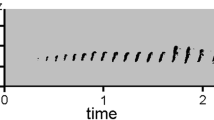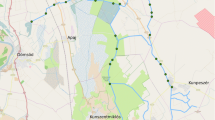Abstract
Male vocalizations associated with courtship can play a key role in mate selection. They may help females obtain information about males’ quality and identity and/or may contain species-specific properties that help prevent interspecies breeding. Despite vocalizations being a prominent part of the courtship of white rhinos, the role that they play in white rhino breeding behaviour has not been extensively studied. Both southern (SWR) and critically endangered northern white rhino (NWR) males intensively vocalize during courtship with hic calls. We examined these calls and found that call properties differed between NWR and SWR males. In addition, we found that individual SWR males could be identified with a high degree of accuracy using their hic calls and that the signature information capacity in hic calls would allow females to individually recognize about 11 adult males living in or moving through their home-ranges, which may help with mate selection. Then, we conducted playback experiments with wild anoestrus SWR females. The females discriminated between the NWR and SWR hic calls and between the SWR hic and SWR pant calls. However, we only found differences in the latency of observed behaviours, not in their duration or in the intensity of females’ reaction. This might suggest that females which are not in oestrus are not highly responsive to a male’s motivation (i.e., seeking contact or mating), but are more interested in assessing his dominance status or familiarity. Ultimately, our results indicate that courtship hic calls encode information which might help females choose mating partners.




Similar content being viewed by others
References
Arnold BD, Wilkinson GS (2011) Individual specific contact calls of pallid bats (Antrozous pallidus) attract conspecifics at roosting sites. Behav Ecol Sociobiol 65:1581–1593
ASAB/ABS (2017) Guidelines for the treatment of animals in behavioural research and teaching. Anim Behav 123:1–2
Beecher MD (1982) Signature Systems and Kin Recognition. Am Zool 22:477–490
Beecher MD (1989) Signalling systems for individual recognition: an information theory approach. Anim Behav 38:248–261
Benson-Amram S, Heinen VK, Dryer SL, Holekamp KE (2011) Numerical assessment and individual call discrimination by wild spotted hyenas, Crocuta crocuta. Anim Behav 82:743–752
Bradbury JW, Vehrencamp SL (1998) Principles of animal communication. Sinauer Associates, Sunderland
Briefer EF (2012) Vocal expression of emotions in mammals: mechanisms of production and evidence. J Zool 288:1–20
Brown MT, Wicker LR (2000) Discriminant analysis. In: Brown SD, Tinsley HEA (eds) Handbook of applied multivariate statistics and mathematical modelling. Academic Press, Hoboken, pp 209–235
Carter GG, Logsdon R, Arnold BD, Menchaca A, Medellin RA (2012) Adult vampire bats produce contact calls when isolated: acoustic variation by species, population, colony, and individual. PLoS ONE 7:e38791
Cinková I, Policht R (2014) Contact Calls of the Northern and Southern White Rhinoceros Allow for Individual and Species Identification. PLoS ONE 9:e98475
Cinková I, Policht R (2016) Sex and species recognition by wild male southern white rhinoceros using contact pant calls. Anim Cogn 19:375–386
Cinková I, Shrader AM (2020) Rival assessment by territorial southern white rhinoceros males via eavesdropping on the contact and courtship calls. Anim Behav 166:19–31
Emslie RH, Milliken T, Talukdar B, Burgess G, Adcock K, Balfour D, Knight MH (2019) African and Asian Rhinoceroses—Status, Conservation and Trade. A report from the IUCN Species Survival Commission (IUCN SSC) African and Asian Rhino Specialist Groups and TRAFFIC to the CITES Secretariat pursuant to Resolution Conf. 9.14 (Rev. CoP17). In: Report to CITES 17th meeting (Colombo, June 2019), CoP 18 Doc.83.1 annex 3:1–38
Groves CP, Fernando P, Robovský J (2010) The sixth rhino: a taxonomic re-assessment of the critically endangered northern white rhinoceros. PLoS ONE 5:e9703
Groves CP, Cotterill FPD, Gippoliti S, Robovský J, Roos C, Taylor PJ, Zinner D (2017) Species definitions and conservation: a review and case studies from African mammals. Conserv Genet 18:1247–1256
Hermes R, Hildebrandt TB, Blottner S, Walzer C, Silinski S, Patton ML, Wibbelt G, Schwarzenberger F, Göritz F (2005) Reproductive soundness of captive southern and northern white rhinoceroses (Ceratotherium simum simum, C. s. cottoni): evaluation of male genital tract morphology and semen quality before and after cryopreservation. Theriogenology 63:219–238
Hermes R, Hildebrandt TB, Walzer C, Göritz F, Patton ML, Silinski S, Anderson MJ, Reid CE, Wibbelt G, Tomasova K, Schwarzenberger F (2006) The effect of long non-reproductive periods on the genital health in captive female white rhinoceroses (Ceratotherium simum simum, C. s. cottoni). Theriogenology 65:1492–1515
Hillman-Smith KM, Oyisenzoo M, Smith F (1986) A last chance to save the northern white rhinoceros Ceratotherium simum cottoni. Oryx 20:20–26
Knight M (2011) African Rhino specialist group report. Pachyderm 49:6–15
Kondo N, Watanabe S (2009) Contact calls: information and social function. Jpn Psychol Res 51:197–208
Kretzschmar P, Auld H, Boag P, Gansloßer U, Scott C, van Coeverden de Groot PJ, Courtiol A (2020) Mate choice, reproductive success and inbreeding in white rhinoceros: new insights for conservation management. Evol Appl 13:699–714
Leliveld LM, Scheumann M, Zimmermann E (2011) Acoustic correlates of individuality in the vocal repertoire of a nocturnal primate (Microcebus murinus). J Acoust Soc Am 129:2278–2288
Lindburg DG, Fitch-Snyder H (1994) Use of behavior to evaluate reproductive problems in captive mammals. Zoo Biol 13:433–445
Linhart P, Osiejuk TS, Budka M, Šálek M, Špinka M, Policht R, Syrová M, Blumstein DT (2019) Measuring individual identity information in animal signals: overview and performance of available identity metrics. Methods Ecol Evol 10:1558–1570
Linn SN, Schmidt S, Scheumann M (2021) Individual distinctiveness across call types of the southern white rhinoceros (Ceratotherium simum simum). J Mammal 102:440–456
Marneweck C, Jürgens A, Shrader AM (2018) Ritualised dung kicking by white rhino males amplifies olfactory signals but reduces odour duration. J Chem Ecol 44:875–885
McElligott AG, Hayden TJ (1999) Context-related vocalization rates of fallow bucks, Dama dama. Anim Behav 58:1095–1104
McGregor PK, Catchpole CK, Dabelsteen T, Falls JB, Fusani L, Gerhard C, Gilbert F, Horn AG, Klump GM, Kroodsma DE, Lambrechts MM, McComb KE, Nelson DA, Pepperberg IM, Ratcliffe L, Searcy WA, Weary DM (1992) Design of playback experiments: the Thornbridge Hall NATO ARW consensus. In: McGregor PK (ed) Playback and studies of animal communication. Plenum, New York, pp 1–9
Moodley Y, Russo IRM, Robovský J, Dalton DL, Kotzé A, Smith S, Stejskal J, Ryder OA, Hermes R, Walzer C, Bruford MW (2018) Contrasting evolutionary history, anthropogenic declines and genetic contact in the northern and southern white rhinoceros (Ceratotherium simum). Proc Biol Sci 285:20181567
Mundry R, Sommer C (2007) Discriminant function analysis with nonindependent data: consequences and an alternative. Anim Behav 74:965–976
Nieder A, Mooney R (2019) The neurobiology of innate, volitional and learned vocalizations in mammals and birds. Philos Trans R Soc Lond B Biol Sci B 375:20190054
Ord TJ, Stamps JA (2009) Species identity cues in animal communication. Am Nat 174:585–593
Owen-Smith RN (1973) The behavioural ecology of the white rhinoceros. Dissertation, University of Wisconsin, Madison
Policht R, Tomášová K, Holečková D, Frynta D (2008) The vocal repertoire in northern white rhinoceros (Ceratotherium simum cottoni) as recorded in the last surviving herd. Bioacoustics 18:69–96
Reby D, Joachim J, Lauga J, Lek S, Aulagnier S (1998) Individuality in the groans of fallow deer (Dama dama) bucks. J Zool 245:79–84
Saragusty J, Diecke S, Drukker M, Durrant B, Ben-Nun IF, Galli C, Göritz F, Hayashi K, Hermes R, Holtze S, Johnson S, Lazzari G, Loi P, Loring JF, Okita K, Renfree MB, Seet S, Voracek T, Stejskal J, Ryder OA, Hildebrandt TB (2016) Rewinding the process of mammalian extinction. Zoo Biol 35:280–292
Schrader L, Hammerschmidt K (1997) Computer-aided analysis of acoustic parameters in animal vocalisations: a multi-parametric approach. Bioacoustics 7:247–265
Shrader AM, Owen-Smith N (2002) The role of companionship in the dispersal of white rhinoceroses (Ceratotherium simum). Behav Ecol Sociobiol 52:255–261
Sokal RR, Rohlf FJ (2012) Biometry: The Principles and Practice of Statistics in Biological Research. W.H. Freeman and Company, New York
Tibbetts EA, Dale J (2007) Individual recognition: it is good to be different. Trends Ecol Evol 22:529–537
Tulving E, Kroll N (1995) Novelty assessment in the brain and longterm memory encoding. Psychon Bull Rev 2:387–390
van Gyseghem R (1984) Observations on the ecology and behaviour of the northern white rhinoceros (Ceratotherium simum cottoni). Z Saugetierkd 49:348–358
Vrba I, Donat P (1993) Activities version 2.1. Computer programme for behavioural studies
Waser PM, Brown CH (1984) Is there a “sound window” for primate communication? Behav Ecol Sociobiol 15:73–76
Watts HE, Blankenship LM, Dawes SE, Holekamp KE (2010) Responses of spotted hyenas to lions reflect individual differences in behavior. Ethology 116:1199–1209
White AM, Swaisgood RR, Czekala N (2007) Ranging patterns in white rhinoceros, Ceratotherium simum simum: implications for mating strategies. Anim Behav 74:349–356
Wyman MT, Charlton BD, Locatelli Y, Reby D (2011) Variability of female responses to conspecific vs. heterospecific male mating calls in polygynous deer: an open door to hybridization? PLoS ONE 6:23296
Wyman MT, Locatelli Y, Charlton BD, Reby D (2014) No preference in female sika deer for conspecific over heterospecific male sexual calls in a mate choice context. J Zool 293:92–99
Acknowledgements
We would like to thank Ezemvelo KwaZulu-Natal Wildlife (EKZNW) for permission to work in Hluhluwe-iMfolozi Park and Dave Druce and Jed Bird (EKZNW) for logistical support during our study. We are thankful to Stanislav Bureš (Palacký University Olomouc) for his support of this study and to Richard Policht (Czech University of Life Sciences Prague) for providing recordings of two northern white rhino males. Two anonymous referees provided valuable comments, which helped to improve the manuscript.
Funding
This research was supported by the National Research Foundation (Grant to A.M.S: 114622) and by Mark McCann. I.C. was supported by the Department of Zoology, Palacký University Olomouc and the Internal Grant Agency of Palacký University Olomouc (IGA_PrF_2017_023, IGA_PrF_2018_026).
Author information
Authors and Affiliations
Contributions
IC conceived the study and IC and AMS designed it. IC performed data collection and analysis. The first draft was written by IC and AMS commented on and edited previous versions of the manuscript. Both authors read and approved the final manuscript.
Corresponding author
Ethics declarations
Conflict of interest
The authors declare that they have no competing interests.
Ethics approval
The experimental procedures were approved by the Animal Ethics Committee of University of KwaZulu-Natal and given the reference number AREC/001/017. This work followed the ASAB/ABS (2017) guidelines for the treatment of animals in behavioural research and teaching.
Additional information
Publisher's Note
Springer Nature remains neutral with regard to jurisdictional claims in published maps and institutional affiliations.
Rights and permissions
About this article
Cite this article
Cinková, I., Shrader, A.M. Individuality, species-specific features, and female discrimination of male southern white rhinoceros courtship calls. Anim Cogn 25, 769–782 (2022). https://doi.org/10.1007/s10071-021-01591-4
Received:
Revised:
Accepted:
Published:
Issue Date:
DOI: https://doi.org/10.1007/s10071-021-01591-4




